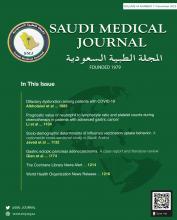Sarcopenia, defined as the age-related loss of whole-body skeletal muscle mass, muscle quality and muscle function, is a new geriatric syndrome associated with a series of adverse health outcomes in the elderly, including reduced physical performance, lower quality of life, functional decline, accidental falls, development of frailty, higher health care costs, and increased all-cause mortality. In particular, reduction of muscle strength may destroy the balance of the body and significantly increased the risk for accidental falls.1 It has been supposed that substantial physiological changes (namely, systemic chronic low-grade inflammatory state, hormonal, and an increased level of oxidative stress) occur with increasing age and induce cellular damage in muscle and the onset of sarcopenia. It has been shown that the incidence of sarcopenia has increased worldwide. However, the etiology and risk factors of sarcopenia are very complex. The aim of this study was to provide a picture of the prevalence of sarcopenia and identify dietary factors among older Chinese adults.
In recent years, the aging population has increased substantially in China. By the end of 2020, the number of adults aged 60 years and above reached 264 million, accounting for 18.7% of the total population (of which 190 million people aged 65 and above, accounting for 13.50%) according to the seventh national census carried out by the National Bureau of Statistics. China is the country with the largest elderly population in the world.2 With the acceleration of population aging, the prevalence of various chronic diseases caused by aging, such as sarcopenia and frailty, has received increasing attention.
To date, numerous studies have been carried out to determine the epidemiology of sarcopenia in older Chinese adults.3-8 The prevalence of sarcopenia was characterized by the following: I) sarcopenia occurred frequently in older Chinese people, and the prevalence estimates (8-14% of men vs. 9-12% of women) were comparable with those among Europeans (13% of men vs. 14% of women), even though older non-Asian adults were reported to be more prone to sarcopenia than older Asian adults;4-6 II) it remains unknown whether gender is independently associated with sarcopenia. Most previous studies indicated that sarcopenia was more common among men than among women.9 However, some other studies showed that a significantly higher prevalence of sarcopenia was found among women than among men;4,8 III) there was variation among populations from different settings. Sarcopenia was more prevalent (29% of men vs. 23% of women) among hospitalized older Chinese patients than among community-dwelling elderly individuals (13% of men vs. 11% of women), while a high risk of prevalent sarcopenia (26% of men vs. 34% of women) was found among nursing home residents.5-7 Furthermore, rural elderly individuals were more vulnerable to sarcopenia than urban elderly individuals.6 For instance, in the same district, the prevalence of sarcopenia was 31% among older inpatients, whereas it was only 13.1% among rural and 7.0% among urban community-dwelling elderly individuals;3,10 IV) different ethnicities presented different prevalences. A significantly higher prevalence of sarcopenia was found among people of other ethnicities (namely, Tujia ethnicity) than among people of Han ethnicity.4
Currently, a series of studies have identified that associated factors, such as older age, cigarette smoking, chronic diseases, underweight/malnutrition, and lower physical activity levels, are associated with the incidence of sarcopenia, whereas younger age, no smoking, higher body mass index, and appropriate physical activity are related to its reversibility.3,4,8
In addition to the above factors, prospective studies have identified that certain nutrients play a pivotal role in affecting the occurrence of sarcopenia with aging. First, the importance of protein and vitamin D in relation to skeletal muscle mass and function has been studied, even though the source and dose for the greatest benefit remain unclear.11,12 Second, in terms of antioxidant vitamins (vitamin E, carotenoids, and vitamin C), selenium, magnesium, and omega-3 fatty acids have demonstrated value in preventing or slowing down aging-related decline in muscle mass and muscle quality.13,14 Third, considering the combination and interaction of various nutrients and food types in the daily diet, most studies focus on the dietary pattern approach to investigate its potential impact on the prevalence of sarcopenia. Previous studies reported that the Mediterranean diet as a healthy eating pattern characterized by a high consumption of fresh vegetables and fruits, fish, olive oil, whole grains and grape wine, and a low intake of red meat, may exert protective effects against muscle loss and sarcopenia. Additionally, what is even more important is that a balanced diet rich in protein, vegetables, and fruits may offer the greatest benefit in preventing muscle wasting and may be adopted as one of the nutritional strategies for sarcopenia prevention and treatment.15 Therefore, improving nutrition and daily diet may be effective for avoiding Chinese older adults suffering from sarcopenia.
In conclusion, considering the rapid growth of the aging population in China, efforts should be carried out earlier to assess nutritional status in older adults and lifestyle interventions such as physical activity and nutrition should be adopted to prevent the onset of sarcopenia and related diseases, especially for elderly individuals.
Acknowledgment
The author gratefully acknowledge American Journal Experts (www.aje.cn) for English language editing.
Footnotes
Disclosure. This study was supported by the Clinical Research and Transformation Fund of Sichuan Provincial People’s Hospital,Chengdu, China (2021LY10).
- Received May 21, 2023.
- Accepted September 12, 2023.
- Copyright: © Saudi Medical Journal
This is an Open Access journal and articles published are distributed under the terms of the Creative Commons Attribution-NonCommercial License (CC BY-NC). Readers may copy, distribute, and display the work for non-commercial purposes with the proper citation of the original work.






